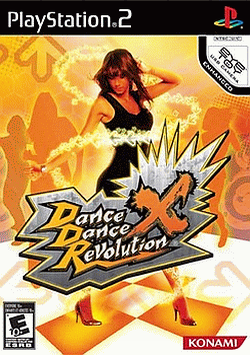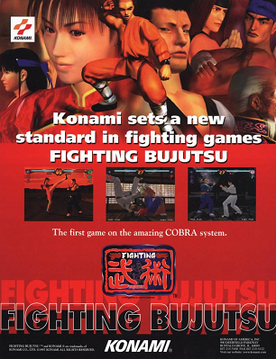Gameplay

Konami's Open Golf Championship is a golf simulation played with a joystick. [1]
| Konami's Open Golf Championship | |
|---|---|
| Developer(s) | Konami |
| Publisher(s) | Konami |
| Platform(s) | Arcade |
| Release | 1994 |
Konami's Open Golf Championship is a 1994 arcade game developed and published by Konami. This game is a sequel to Konami's earlier arcade game Golfing Greats, released three years earlier in 1991, and it is known as Golfing Greats 2 in Japan. While the original Golfing Greats used the same hardware as Teenage Mutant Ninja Turtles: Turtles in Time , Golfing Greats 2 uses the SYSTEM-GX hardware, allowing for better graphics.

Konami's Open Golf Championship is a golf simulation played with a joystick. [1]
Next Generation reviewed the arcade version of the game, rating it two stars out of five, and stated that "This could have been a good game if its control were better, rather than the decent game it is." [1]
Dance Dance Revolution (DDR) is a music video game series produced by Konami. Introduced in Japan in 1998 as part of the Bemani series, and released in North America and Europe in 1999, Dance Dance Revolution is the pioneering series of the rhythm and dance genre in video games. Players stand on a "dance platform" or stage and hit colored arrows laid out in a cross with their feet to musical and visual cues. Players are judged by how well they time their dance to the patterns presented to them and are allowed to choose more music to play to if they receive a passing score.

Treasure Co., Ltd. is a Japanese video game developer based in Tokyo known for its action, platform, and shoot 'em up games. The company was founded in 1992 by former Konami employees seeking to explore original game concepts and free themselves from Konami's reliance on sequels. Their first game, Gunstar Heroes (1993) on the Sega Genesis, was a critical success and established a creative and action-oriented design style that would continue to characterize their output. Treasure's philosophy in game development has always been to make games they enjoy, not necessarily those that have the greatest commercial viability.

Beatmania (ビートマニア) is a rhythm video game developed and distributed by Japanese game developer Konami and first released in December 1997. It contributed largely to the boom of music games in 1998, and the series expanded not only with arcade sequels, but also moved to home consoles and other portable devices, achieving a million unit sales. The Bemani line of music games from Konami is named after the series, was first adopted in the arcade release of Beatmania 3rdMix and kept ever since. The series came to an end with the last game being Beatmania The Final, released in 2002.

Konami Group Corporation is a Japanese multinational entertainment company and video game developer and publisher headquartered in Chūō, Tokyo. The company also produces and distributes trading cards, anime, tokusatsu, pachinko machines, slot machines, and arcade cabinets. Konami has casinos around the world and operates health and physical fitness clubs across Japan.

Frogger is a 1981 arcade action game developed by Konami and published by Sega. In North America, it was distributed by Sega/Gremlin. The object of the game is to direct five frogs to their homes by dodging traffic on a busy road, then crossing a river by jumping on floating logs and alligators.

Track & Field, also known as Hyper Olympic in Japan and Europe, is a 1983 Olympic-themed sports video game developed by Konami for arcades. The Japanese release sported an official license for the 1984 Summer Olympics. In Europe, the game was initially released under the Japanese title Hyper Olympic in 1983, before re-releasing under the US title Track & Field in early 1984.

Gitadora is a music video game series produced by Konami. The series consists of two games, GuitarFreaks and DrumMania, where players use game controllers modeled after musical instruments to perform the lead guitar, bass guitar and drums of numerous songs across a wide range of genres by matching scrolling musical notes patterns shown on screen. Players are scored for successfully-hit notes, but may fail a song if they miss too many notes. The series has featured numerous game modes, and supports both single-player and multiplayer modes where up to three players can perform together. Some earlier versions of the game could also be linked with Keyboardmania.
The Panasonic M2 is a video game console platform developed by 3DO and then sold to Matsushita, a company known outside Japan by the brand Panasonic. Initially announced as a peripheral chip for the 3DO Interactive Multiplayer, it was later unveiled as a standalone console. The console was cancelled in 1997, but the M2 technology was incorporated into other devices.

Adventure Vision is a cartridge-based video game console released by Entex Industries in either August or October 1982. The launch price of the system was $79.95. The monitor, game controls, and computer hardware are all contained within a single portable unit. The LED monitor can only display red pixels. Four games were released, all of which are arcade ports. Approximately 10,000 were produced.

Teenage Mutant Ninja Turtles: Turtles in Time, released as Teenage Mutant Hero Turtles: Turtles in Time in Europe, is a beat 'em up arcade video game produced by Konami and released in 1991. A sequel to the original Teenage Mutant Ninja Turtles arcade game, it is a scrolling beat 'em up type game based mainly on the 1987 TMNT animated series. Originally an arcade game, Turtles in Time was ported to the Super Nintendo Entertainment System in 1992 under the title Teenage Mutant Ninja Turtles IV: Turtles in Time, continuing the numbering from the earlier Turtles games released on the original NES. That same year, a game that borrowed many elements, Teenage Mutant Ninja Turtles: The Hyperstone Heist, was released for the Sega Genesis.

Teenage Mutant Ninja Turtles III: The Manhattan Project is a side-scrolling beat-'em-up released by Konami for the Family Computer (Famicom) in Japan in 1991 and for the Nintendo Entertainment System in North America in 1992. It is the third video game iteration of the Teenage Mutant Ninja Turtles for the NES. The game features play mechanics similar to the previous game, Teenage Mutant Ninja Turtles II: The Arcade Game, but it is an original title for the NES without any preceding arcade version. It is based on the 1987 Teenage Mutant Ninja Turtles animated series, being released after the show's 5th season. The game was re-released as part of Teenage Mutant Ninja Turtles: The Cowabunga Collection in 2022.
A dedicated console is a video game console that is limited to one or more built-in video game or games, and is not equipped for additional games that are distributed via ROM cartridges, discs, downloads or other digital media. Dedicated consoles were very popular in the first generation of video game consoles until they were gradually replaced by second-generation video game consoles that use ROM cartridges.

Dance Dance Revolution X is a music video game developed by Konami. A part of the Dance Dance Revolution series, it was announced in 2008 for Japan and on May 15, 2008, for the North American PlayStation 2. The arcade version was announced on July 7, 2008, July 9, 2008 in Europe, and July 10, 2008, for North America. Released to celebrate the 10th anniversary of Dance Dance Revolution, DDR X sports an improved interface, new music, and new modes of play. The arcade release featured an overhauled cabinet design with a widescreen display, e-Amusement and USB access, and an improved sound system. Despite such new design of its arcade cabinet, upgrade kit to change the edition of DDR on its first generation arcade cabinet from SuperNOVA2 to X is also available. The PlayStation 2 release has link ability with the arcade machine, multi-player support over LAN, and other improved and returning features such as EyeToy support. DDR X was called a "truly global version", with a multi-regional release by all three major Konami houses.

WEC Le Mans, known as WEC Le Mans 24 in Japan, is a racing simulation video game released in arcades by Konami in 1986. It was the first racing video game to depict the 24 Hours of Le Mans World Endurance Championship (WEC). The Lap of Le Mans is split up into three sections, during which the time of day changes from day to dusk, dusk to night, and night to dawn.

The System 573 is an arcade system board made by Konami based on the original PlayStation. The hardware was used primarily for Konami's Bemani series of music video game arcades, including the popular Dance Dance Revolution series introduced in 1998. The System 573 is available is configurable with various expansion IO boards to add extra input or output, such as the analog and digital I/O boards for Dance Dance Revolution and other Bemani games. Systems with these IO boards are often called System 573 Analog and System 573 Digital respectively. There is another variant called the System 573 Satellite Terminal which allows for up to eight cabinets to be networked to a central one.

Fighting Bujutsu, known in Japan as Fighting Wu-Shu, is an August 1997 3D fighting arcade game developed and published by Konami. It is Konami's second attempt in the 3D fighting game market, after their 1996 Lightning Legend: Daigo no Daibouken, and was released only in arcades.

eFootball Pro Evolution Soccer, known as eFootball World Soccer Winning Eleven in Japan, is a series of association football simulation video games developed by Konami Digital Entertainment Co., Ltd. and published by Konami.

Teenage Mutant Ninja Turtles, released in Japan as TMNT: Super Kame Ninja and in Europe as Teenage Mutant Hero Turtles, is a 1989 beat 'em up arcade game released by Konami. It is based on the Teenage Mutant Ninja Turtles franchise, including the first animated series that began airing two years earlier. In the game, up to four players control the titular Ninja Turtles, fighting through various levels to defeat the turtles' enemies, including the Shredder, Krang and the Foot Clan. Released during a high point in popularity for the Teenage Mutant Ninja Turtles franchise, the arcade game was a worldwide hit, becoming the highest-grossing dedicated arcade game of 1990 in the United States and Konami's highest-grossing arcade game. Versions for various home systems soon followed, including the Nintendo Entertainment System. A sequel, Teenage Mutant Ninja Turtles: Turtles in Time, was released in 1991.

GTI Club: Rally Côte d'Azur is a racing video game developed and published by Konami for the arcades in 1996. It is the first game in the GTI Club series. It was re-released for PlayStation Network in 2008.